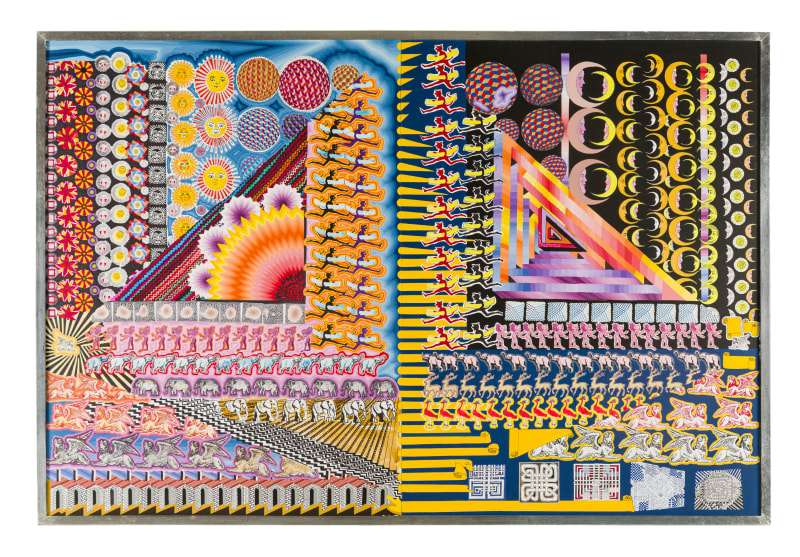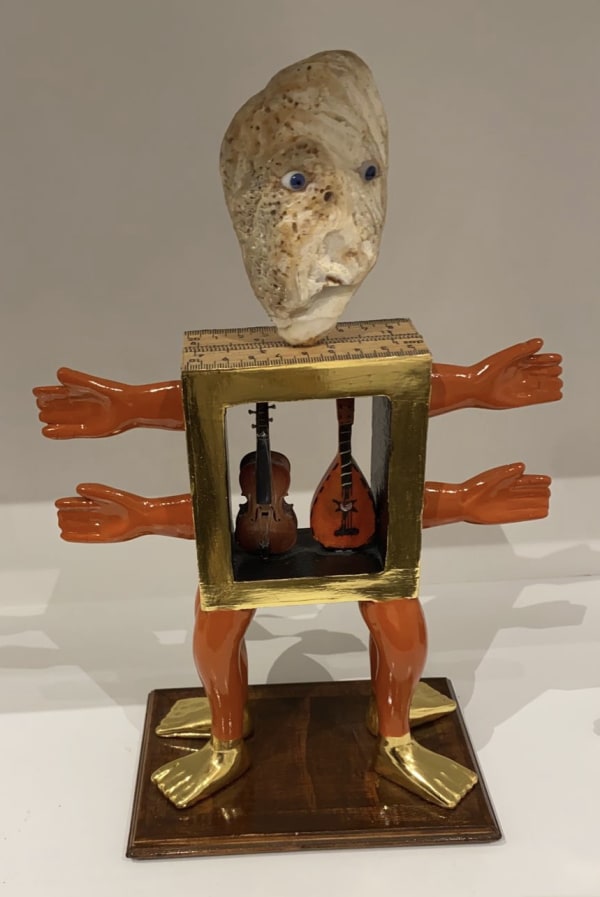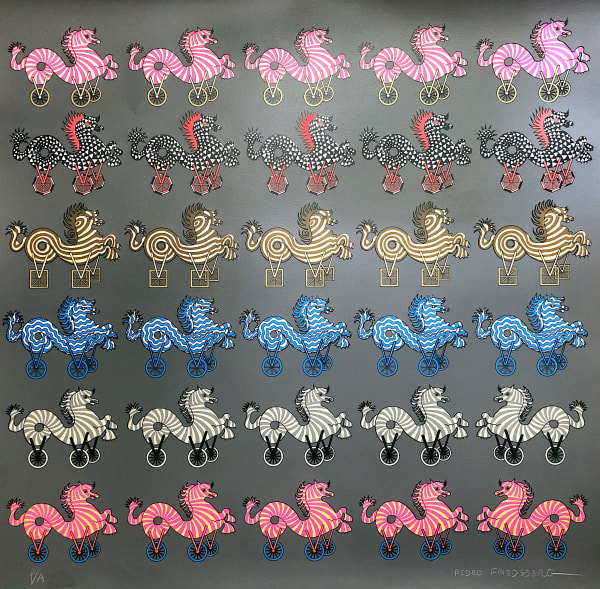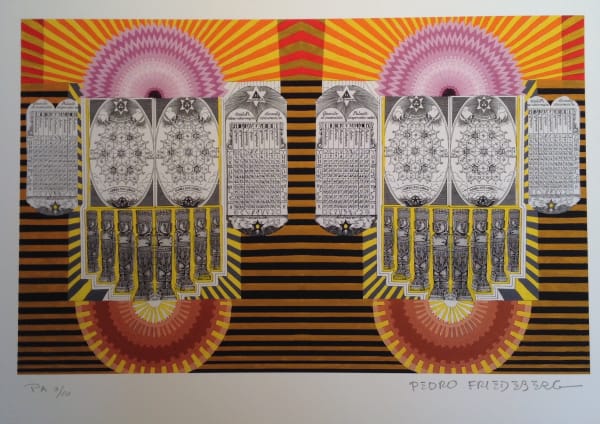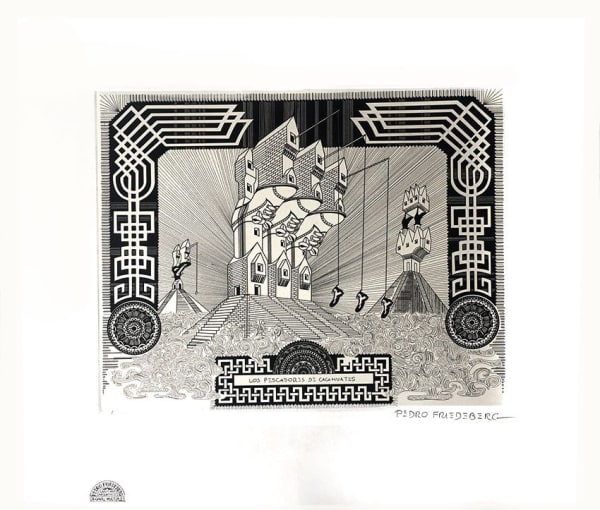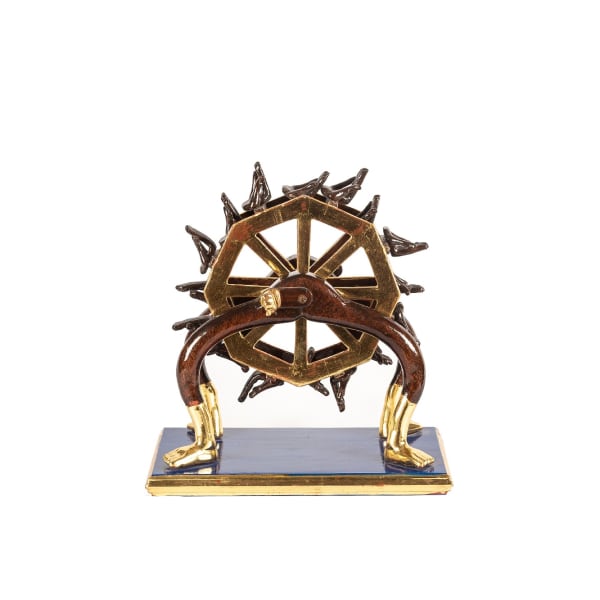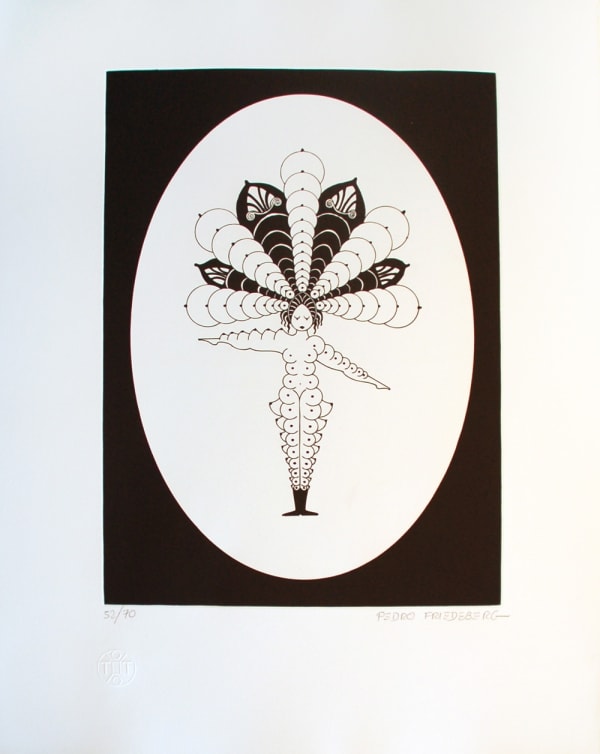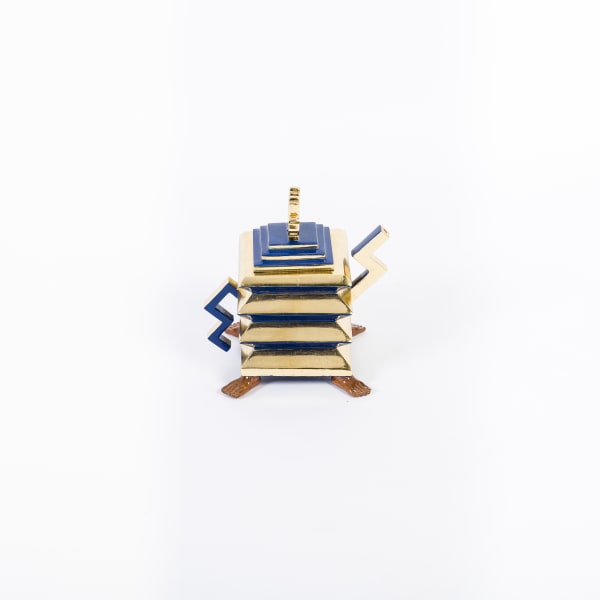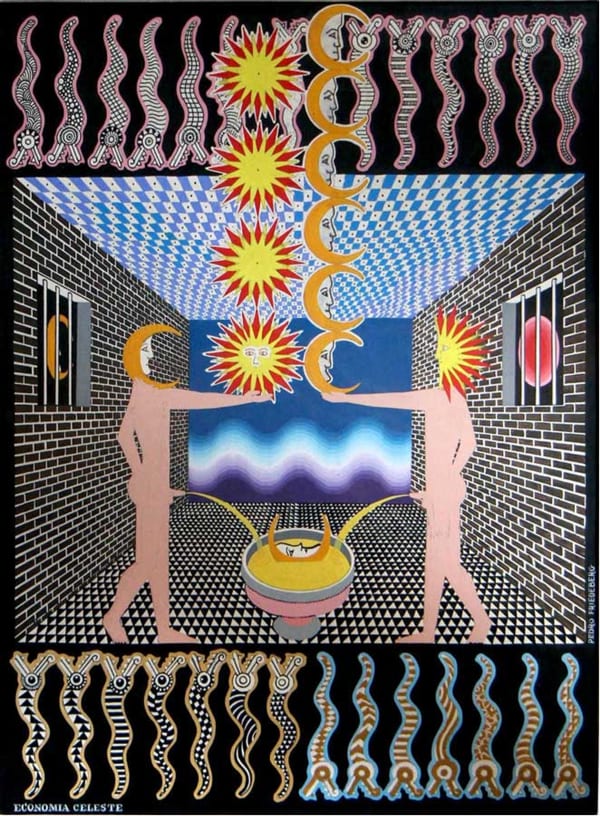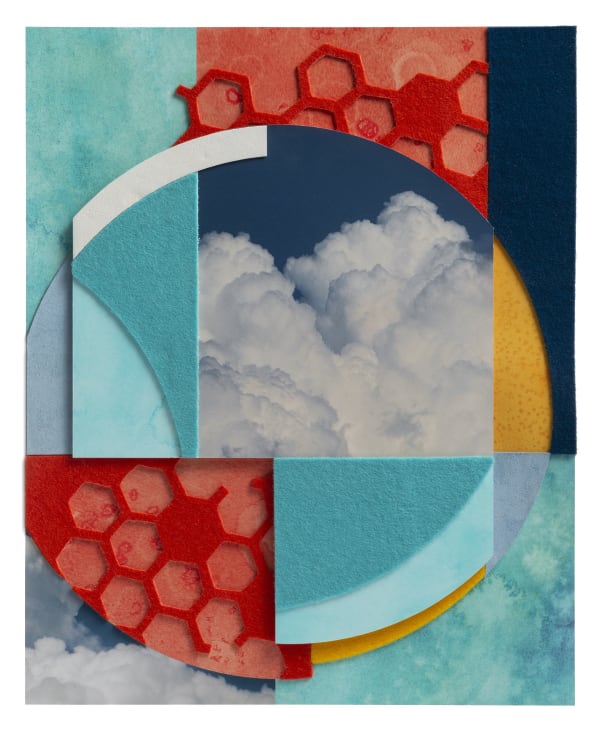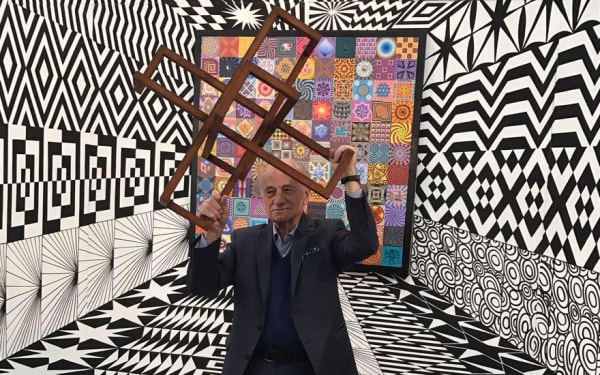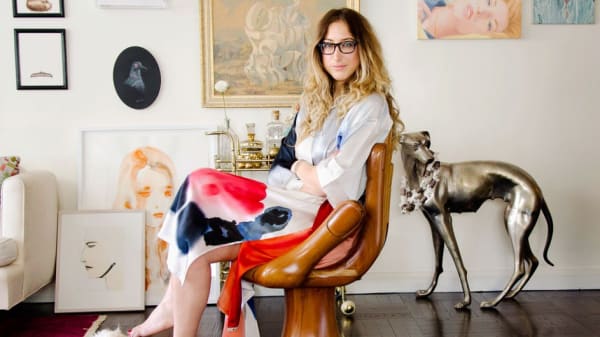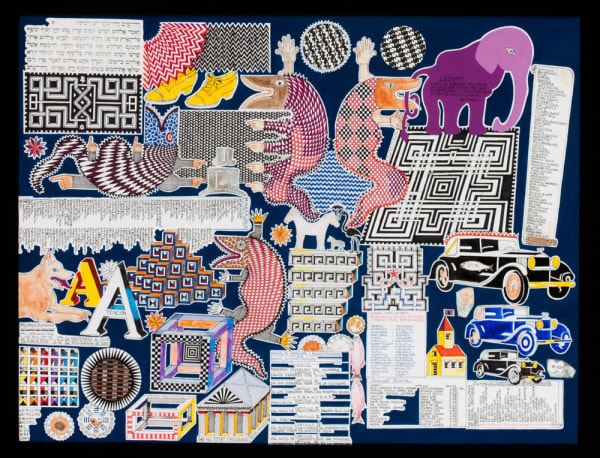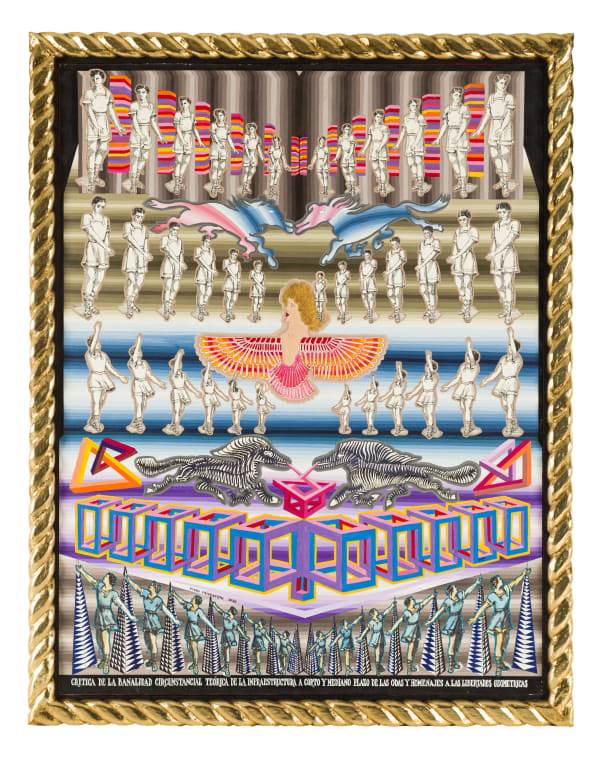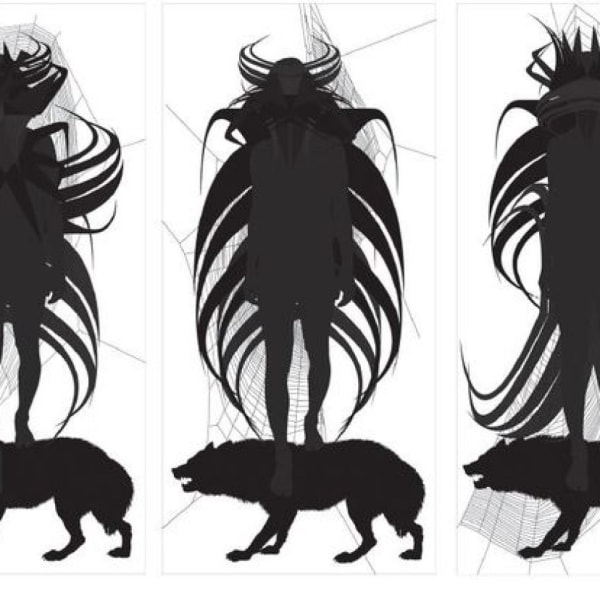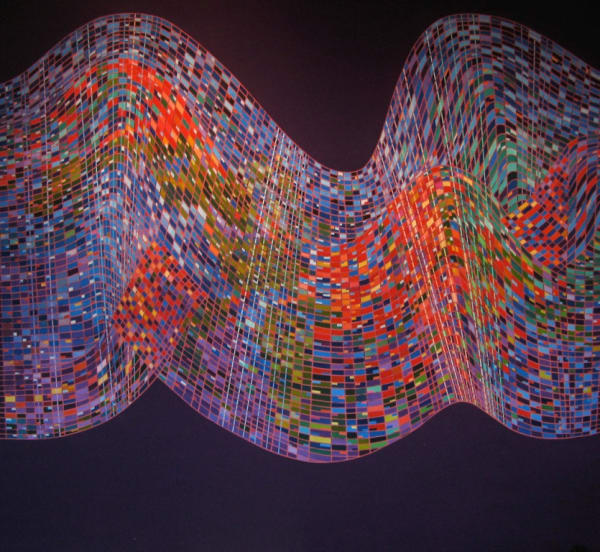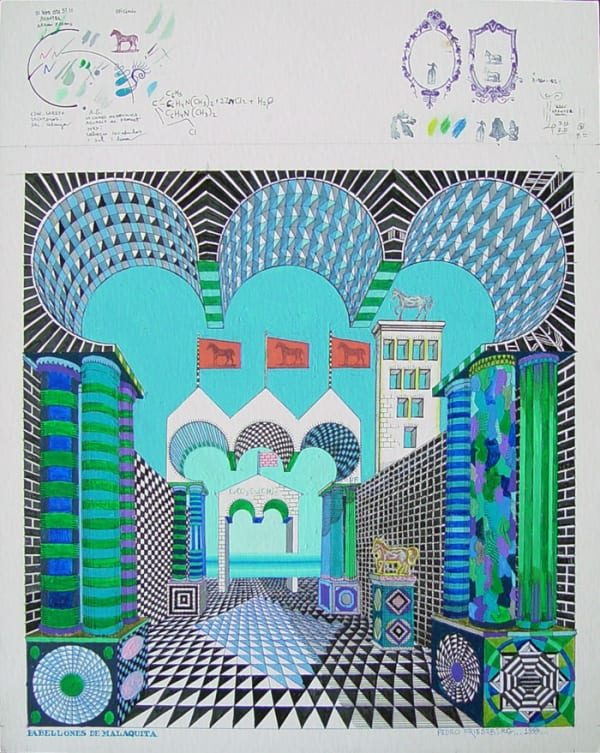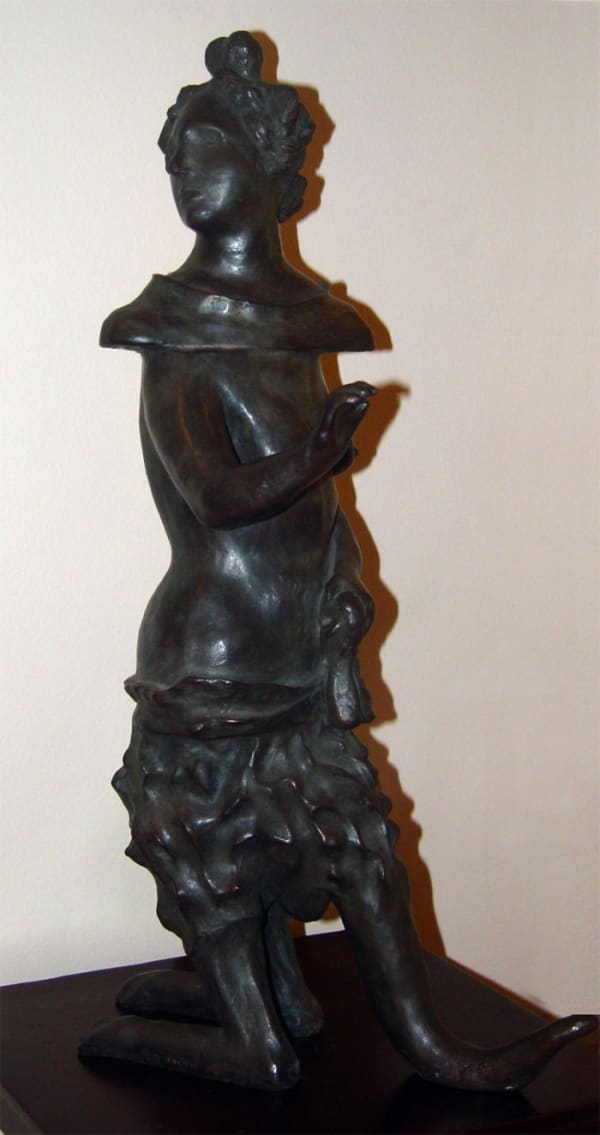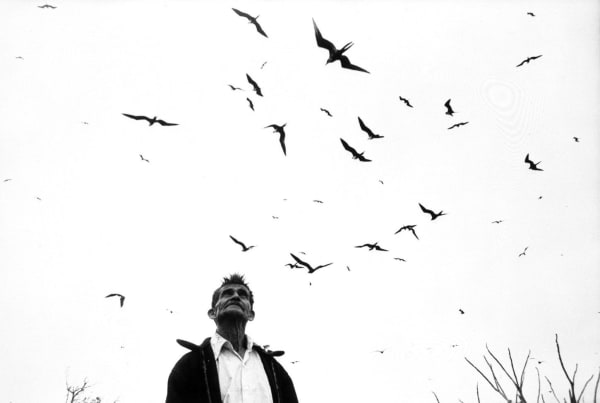Pedro Friedeberg Mexican, b. 1936
Pedro Friedeberg and his parents immigrated to Mexico in 1940 from Florence, Italy. As a child he was particularly drawn to the illusionistic representation of architectural space, both in Italian Renaissance architecture and 18th century painting, as well as in the work of M.C. Escher and Josef Albers. He studied architecture at the Universidad Iberoamericana, México City, where he was profoundly influenced by Mathias Goeritz (1915-1990) and his Bauhaus ways of teaching. Goeritz became a mentor, lifelong friend, collaborator, and champion of Friedeberg’s distinctive work.
Although Friedeberg’s artworks are sometimes described as Surrealist or Fantastic Realist, they are not easily definable in terms of conventional categories. His works include paintings, sculpture, printmaking, installations, and constructed montages, where the surrealist space is populated with borrowed and personal symbols. “Who knows what one does or why? I think of my work as a pastiche. There’s a little bit of everything I like in there.” – Pedro Friedeberg.
Friedeberg has held individual exhibitions in Mexico, the United States, and Europe, notably mentioning Una retrospectiva Pedro Friedeberg: Arquitecto de confusiones impecables, Museo del Palacio de Bellas Artes, Mexico City, Mexico; Found in Translation: Design in California and Mexico, 1915-1985, LACMA, Los Angeles, CA, and Objects of Desire: Surrealism and Design 1924- Today, the Design Museum, London, England. He has also been featured and reviewed in publications such as Architectural Digest, Elle Decor, Noir Magazine, Vogue México, and W Magazine. The artist has exhibited extensively in museums, among others, Hamburger Bahnhof Museum, Berlin, Germany; Museum of Contemporary Art, Phoenix, AZ; San Antonio Museum of Art, TX; Museo de Arte Moderno, Tel Aviv, Israel; the Casa de las Americas, Habana, Cuba, and many more.
Friedberg’s artworks can be found in more than 50 international museum collections, including the Museum of Modern Art (MoMA), New York, NY; the Musée d’Art Moderne de la Ville de Paris, Paris France; Musée du Louvre, Pavillon Art Décoratifs, Paris, France; Smithsonian American Art Museum, Washington, D.C.; Cafesjian Center for the Arts, Yerevan, Armenia; The Library of Congress, Washington, D.C and Los Angeles County Museum of Art, CA. among others.
-
 Pedro FriedebergBodas triangulares orgánicas interacciones morganáticas, 2021Ink and acrylic on museum board40.5 x 60.5 in
Pedro FriedebergBodas triangulares orgánicas interacciones morganáticas, 2021Ink and acrylic on museum board40.5 x 60.5 in
105 x 155 cm -
 Pedro FriedebergHomenaje a Sigmund Freud, 2021Carved, painted, gilt wood, and found object9 x 11.3 x 4 in
Pedro FriedebergHomenaje a Sigmund Freud, 2021Carved, painted, gilt wood, and found object9 x 11.3 x 4 in
22.8 x 28.5 x 10 cm -
 Pedro FriedebergMano roja, 2021Resin18.9 x 11.5 x 9.9 in
Pedro FriedebergMano roja, 2021Resin18.9 x 11.5 x 9.9 in
48 x 29 x 25 cmAP 1/1 -
 Pedro FriedebergTercer banco, 2021Carved, painted, and gilt wood8.3 x 17.4 x 17.4 in
Pedro FriedebergTercer banco, 2021Carved, painted, and gilt wood8.3 x 17.4 x 17.4 in
21.x 44 x 44 cm -
 Pedro FriedebergAfinidades electivas, 2020Ink and acrylic on museum board18.5 x 18.5 in
Pedro FriedebergAfinidades electivas, 2020Ink and acrylic on museum board18.5 x 18.5 in
47 x 47 cm -
 Pedro FriedebergEn tiempos del Rey Bomba, 2020Ink and acrylic on museum board37 x 47.3 in
Pedro FriedebergEn tiempos del Rey Bomba, 2020Ink and acrylic on museum board37 x 47.3 in
93.3 x 120 cm -
 Pedro FriedebergSilla exacta, 2019Hand carved, gilt walnut24.1 x 12.2 x 11.3 in
Pedro FriedebergSilla exacta, 2019Hand carved, gilt walnut24.1 x 12.2 x 11.3 in
61 x 31 x 28.5 cm -
 Pedro FriedebergEl profesor de cuerdas, 2018Carved wood assemlage, gilded, antique figure, seashell, wood rulers and miniature musical instruments12.25 x 8.13 x 4.38 in
Pedro FriedebergEl profesor de cuerdas, 2018Carved wood assemlage, gilded, antique figure, seashell, wood rulers and miniature musical instruments12.25 x 8.13 x 4.38 in
31.1 x 20.7 x 11.1 cm -
 Pedro FriedebergEquinorrodante, Taller Pablo Torrealba, Mexico City, 2018Silkscreen33.5 x 33.5 in
Pedro FriedebergEquinorrodante, Taller Pablo Torrealba, Mexico City, 2018Silkscreen33.5 x 33.5 in
85.1 x 85.1 cmXV / LXX -
 Pedro FriedebergSerenata Equinofebrífuga II, Pablo Torrealba, Mexico City, Mexico, 2017Serigraph30.3 x 30.3 in
Pedro FriedebergSerenata Equinofebrífuga II, Pablo Torrealba, Mexico City, Mexico, 2017Serigraph30.3 x 30.3 in
77 x 77 cmIII / L -
 Pedro FriedebergCarpeta Trapobane, 2016Silkscreen12 3/4 x 17 7/8 in
Pedro FriedebergCarpeta Trapobane, 2016Silkscreen12 3/4 x 17 7/8 in
32.5 x 45.5 cmP/A 3 / 10 -
 Pedro FriedebergCarpeta Trapobane, 2016Silkscreen12.8 x 17.9 in
Pedro FriedebergCarpeta Trapobane, 2016Silkscreen12.8 x 17.9 in
32.5 x 45.5 cmP/A 3 / 10 -
 Pedro FriedebergGeometria Polaca, 2016Acrylic and ink on museum board30 x 30 in
Pedro FriedebergGeometria Polaca, 2016Acrylic and ink on museum board30 x 30 in
76.2 x 76.2 cm -
 Pedro FriedebergLos Pescadores de Cacahuates, 2016Etching22.75 x 26 in
Pedro FriedebergLos Pescadores de Cacahuates, 2016Etching22.75 x 26 in
57.8 x 66 cm5 / 70 -
 Pedro FriedebergRueda quiromántica, 2015Carved, painted, and gilt wood12.3 x 11.1 x 6.8 in
Pedro FriedebergRueda quiromántica, 2015Carved, painted, and gilt wood12.3 x 11.1 x 6.8 in
31.1 x 28.3 x 17.1 cm -
 Pedro FriedebergLa Dirigente del Trafico , 2014Etching25.3 x 19.8 in
Pedro FriedebergLa Dirigente del Trafico , 2014Etching25.3 x 19.8 in
64 x 50 cm52 / 70 -
 Pedro FriedebergSillas III, Lucio Santiago, Oaxaca, Mexico, 2014Serigraph25.3 x 29.8
Pedro FriedebergSillas III, Lucio Santiago, Oaxaca, Mexico, 2014Serigraph25.3 x 29.8
64.3 x 75.7 cm69 / 80 -
 Pedro FriedebergCafetera Zigzagueante, 2012Hand carved wood, paint, and gilt12.5 x 9.1 x 12.1 in
Pedro FriedebergCafetera Zigzagueante, 2012Hand carved wood, paint, and gilt12.5 x 9.1 x 12.1 in
32 x 23 x 30.5 cm -
 Pedro FriedebergRed Table Clock, 1998Wood, acrylic and gold leaf22 x 16 x 8"
Pedro FriedebergRed Table Clock, 1998Wood, acrylic and gold leaf22 x 16 x 8"
55.9 x 40.6 x 20.3 cm -
 Pedro FriedebergEconomía Celeste, 1977Acrylic on museum board25 x 20 in
Pedro FriedebergEconomía Celeste, 1977Acrylic on museum board25 x 20 in
63.5 x 50.8 cm -
 Pedro FriedebergMano Silla (diseno 1962), 1962/2021mahogany wood and silver gilt37 1/2 x 20 1/2 x 20 1/2 in
Pedro FriedebergMano Silla (diseno 1962), 1962/2021mahogany wood and silver gilt37 1/2 x 20 1/2 x 20 1/2 in
95 x 52 x 52 cm
-

Designer Kelly Wearstler Steps Into the Surrealist World of Pedro Friedeberg
Kelly Wearstler, artnet, October 12, 2025 -

Views from Mexico: A 20th-Century Panorama
Meer, September 1, 2025 -

True South: Latin American Art Rising
John Dorfman, Art & Object, December 14, 2024 -

The Staying Power of Pedro Friedeberg
Bryan Rindfuss, W Magazine, December 13, 2024
-

PEDЯO FЯIEDEBEЯG EN UNA NAЯЯATIVA SUЯЯEAL
Isamar Escobar, Noir Magazine, November 27, 2024 -

At 88, Mexican Surrealist Pedro Friedeberg Has Seen It All
William Van Meter, Artnet, July 29, 2024 -

ArtNexus Reviews, Pedro Friedeberg and Mathias Goeritz- Museo Experimental El Eco
Ricardo Pohlenz, ArtNexus , June 1, 2022 -

New exhibition at Ruiz-Healy Art investigates the intersections of neo-surrealism and magic realism
Bryan Rindfuss, San Antonio Current, March 9, 2022
-

San Antonio’s arts community reflects on the milestones of another challenging year
Bryan Rindfuss, San Antonio Current, December 29, 2021 -

Ruiz-Healy Art Celebrates its Quinceañera
Kathleen Petty, San Antonio Magazine, November 19, 2021 -

Pedro Friedeberg: Something Like That!
Wall Street International Magazine, September 8, 2021 -

Pedro Friedeberg: Inventor of alternative realities
Christie's, April 12, 2019
-

‘Interval’ at Ruiz-Healy Art
Neil Fauerso, Glasstire, July 28, 2017 -

10,000 Hardboiled Eggs and the Art of Pedro Friedeberg
Alan Grabinsky, Tablet Magazine, May 4, 2017 -

The Story Behind Pedro Friedeberg's Iconic Hand Chair
Hannah Martin, Architectural Digest, April 21, 2017 -

Ruiz-Healy Art spotlights work by noted Mexican surrealist
Elda Silva, San Antonio Express- News, May 6, 2016
-

Views from Mexico: A 20th Century Panorama
September 5 - October 31, 2025 New York CityRuiz-Healy Art presents Views from Mexico: A 20th-Century Panorama , a group exhibition showcasing works by Dr. Atl, Federico Cantú, Pedro Friedeberg, Mathias Goeritz, Julia Lopez, Feliciano Peña, and Francisco...Read more -

Alchemy: Works on Paper
February 22 - April 1, 2023 San AntonioRuiz-Healy Art is pleased to present Alchemy: Works on Paper. The exhibition will present works by Jesse Amado, Richard "Ricky" Armendariz, Cecilia Biagini, Gaby Collins-Fernandez, Margaret Craig, Andres Ferrandis, Pedro Friedeberg, Cisco Jiménez, Consuelo Jimenez Underwood, Leigh Anne Lester, César A. Martínez, Kanako Namura, Lina Puerta, and Ethel Shipton. Ruiz-Healy Art is proud to be one of only three dealers in the state of Texas that holds membership to the International Fine Print Dealers Association, an organization that maintains the highest standards for works on paper.Read more -

Contemporary Latinx and Latin American Printmakers
September 28 - November 4, 2022 New York CityRuiz-Healy Art is thrilled to present Contemporary Latinx and Latin American Printmakers. The exhibition will present works by César A. Martínez, Juan de Dios Mora, Marta Sánchez, Richard Armendariz, Moses Ros, Pedro Friedeberg, Patssi Valdez, Johanna Calle, Liliana Porter, Michael Menchaca, Francisco Toledo, Carlos Amorales, Vicente Rojo, Cisco Jiménez, Rodolfo Morales, Dr. Lakra, Modesto Bernardo, Ethel Shipton, Alejandro Diaz, Celia Álvarez Muñoz, Roger Von Gunten, Pedro Diego Alvarado-Rivera, Rodolfo Morales, and Carlos Rosales-Silva.Read more -

Neo-Surrealism & Magic Realism
February 16 - May 7, 2022 San AntonioRuiz-Healy Art is pleased to announce "Neo-Surrealism & Magic Realism". The exhibition includes dreamlike and figurative works that reference and react to the current political and ecological context; fantastical visions, mythology, and magical thinking influence the genres. Featured artists include: Juan Alcazar, RF Alvarez, Bruno Andrade, Victor Chaca, Juan de Dios Mora, Pedro Friedeberg, Luis Gal, Irma Guerrero, Roger Von Gunten, Rodolfo Morales, Katie Pell, Gugger Petter, Jose Luis Rivera-Barrera, Shinzaburo Takeda, Leticia Tarrago, Patssi Valdez, and Bettie Ward.Read more
-

Ruiz-Healy Art: Quinceañera
November 18, 2021 - January 29, 2022 San AntonioRuiz-Healy Art is pleased to announce Ruiz-Healy Art: Quinceañera , an exhibition commemorating the fifteen-year anniversary of Ruiz-Healy Art in San Antonio, Texas. The exhibition features work by artists that...Read more -

Pedro Friedeberg: Something Like That!
September 10 - October 23, 2021 New York CityRuiz-Healy Art is pleased to present Pedro Friedeberg: Something like that! The exhibition opens on Friday, September 10th with an opening reception from 6 to 8 pm. A reception with...Read more -

IFPDA Fine Art Print Fair
October 7 - November 1, 2020Ruiz-Healy Art is pleased to announce the gallery's seventh year of participation in the prestigious IFPDA Fine Art Print Fair taking place, this year, in a hybrid online / in-person...Read more -

IFPDA Fine Art Print Fair
October 23 - 27, 2019 New York CityRuiz-Healy Art is pleased to announce the gallery's participation in the prestigious IFPDA Print Fair at the new location in the Javits Center. RHA represents an international roster of artists and places emphasis on a Latin American, borderland, and Texas discourse. Featuring artists Ricky Armendariz, Margarita Cabrera, Patssi Valdez, Pedro Friedeberg, Ethel Shipton, Nate Cassie, Andres Ferrandis, and Cisco Jimenez.Read more
-

McNay Print Fair
March 2 - 3, 2019 San AntonioRuiz-Healy Art presents works at the McNay's 23rd annual Print Fair.Artists featured at the McNay Print Fair will include: Jennifer Ling Datchuk, Ethel Shipton, Rufino Tamayo, Nate Cassie, Graciela Iturbide, Chuck Ramirez, Pedro Friedeberg, Pedro Diego Alvarado, Mark Schlesinger, and Richard Armendariz.Read more -

IFPDA Fine Art Print Fair
October 25 - 28, 2018 New York CityRuiz-Healy Art participates in their fourth consecutive year of the IFPDA, International Fine Print Dealers Association. Artists selected for this year’s fair are: Richard Armendariz, Margarita Cabrera, Jennifer Ling Datchuk, Pedro Friedeberg, Kelly O’Connor, and Michael Menchaca.Read more -

Made in Mexico
September 13 - November 3, 2018 San AntonioRuiz-Healy Art presents Made in Mexico, a group exhibition comprised of Mexican artists. The exhibition explores the ways artists have sought to explain their world in terms of an alternate reality, drawn from imagination, poetry, nature, and myth.Read more -

McNay Print Fair
March 3 - 4, 2018 San AntonioRuiz-Healy Art participates in the McNay's 22nd annual print fair. Artists featured include: Jennifer Ling Datchuk, Ethel Shipton, Nate Cassie, Graciela Iturbide, Chuck Ramirez, Pedro Friedeberg, Pedro Diego Alvarado, Mark Schlesinger, Richard Armendariz, among others.Read more
-

IFPDA Fine Art Print Fair
October 25 - 29, 2017 New York CityRuiz-Healy Art participates in the 2017 IFPDA New York City Print Fair. The Natural and Fantastic are explored through the works of: David Hockney, Jesse Amado, Ricky Armendariz, Nate Cassie, Pedro Friedeberg, Michael Menchaca, Ethel Shipton, Francisco Toledo and Alfredo Zalce.Read more -

Interval
July 29 - September 2, 2017 San AntonioInterval, an artist talk held at Ruiz-Healy Art, invites a pause and a place to consider disparate connections, subtle changes, implied possibilities. Featuring artists Carlos Amorales, Fernando Andrade, Sarah Fox, Pedro Friedeberg, Nicolás Leiva, and James Smolleck.Read more -

Pedro Friedeberg: Praise of Folly
April 17 - June 18, 2016 San AntonioRuiz-Healy Art presents Pedro Friedeberg: Praise of Folly, illusionist works that feature hand woven carpets, paintings, his iconic hand-chairs, fantastical sculptures and prints.Read more -

20th Annual McNay Print Fair
March 5 - 6, 2016 San AntonioRuiz-Healy Art is pleased to participate at the Annual McNay Print Fair showcasing works on paper from; Laura Anderson Barbata, Ricky Armendariz, Pedro Friedeberg, Daniel Guerrero, César Martínez, Cecilia Paredes, and Julie Speed, among othersRead more
-

Art on Paper Fair
March 3 - 6, 2016 New York CityRuiz-Healy Art is pleased to participate at Art on Paper Fair and present a solo booth featuring works on paper by Pedro Friedeberg.Read more -

IFPDA Ink Miami Art Fair
Miami December 3 - 7, 2014Ruiz-Healy Art participates in Ink Miami with the work of Graciela Iturbide, Leigh Anne Lester, Connie Lowe, Cecilia Paredes, Ethel Shipton, Cecilia Biagini and Julie Speed, among others. As well as Francisco Toledo, Pedro Friedeberg, Jesse Amado, Ricky Armendariz, Nate Cassie, Vincent Valdez and the late Chuck Ramirez.Read more -

Latin American Printmakers
May 31 - June 29, 2012 San AntonioAn exhibit of prints featuring work by:Read more
Juan Alcazár, Javier Arévalo, Pedro Diego Alvarado-Rivera, Jose Luis Cuevas, Pedro Friedeberg, Alberto Gironella, Sergio Hernández, Joy Laville, Nicolás Leiva, Rodolfo Morales, Carmen Parra, Shinzaburo Takeda, Francisco Toledo, and Roger Von Gunten. -

Dallas Art Fair
Dallas February 5 - 7, 2010Ruiz-Healy Art participates in the Dallas Art Fair with the work of Pedro Friedeberg, Cecilia Biagini, Carlos Betancourt, Rodolfo Choperena, Cecilia Paredes, Nicolás Leiva and Ray Smith.Read more
-

Arteamericas Art Fair 2009
Miami March 27 - 30, 2009Ruiz-Healy Art is proud to announce its participation in Merril Lynch Arteamericas Fair 2009, featuring works by Pedro Friedeberg, Alfredo de Stéfano, Marysole Worner and Cristina Kahlo.Read more -

Pedro Friedeberg
October 23 - December 13, 2008 San AntonioRuiz-Healy Art celebrates Pedro Friedeberg 50 year career in sculpture, painting, furniture, works on paper, and objects.Read more -

McNay Print Fair
March 22 - 25, 2007 San AntonioFor its debut at the Print Fair, Ruiz-Healy Art will be featuring prints from the premier contemporary artists of Latin America including Rufino Tamayo, Francisco Toledo, and Rodolfo Morales, among others.Read more -

Arteamericas Art Fair 2007
Miami March 16 - 18, 2007Ruiz-Healy Art is pleased to announce its participation in Arteamericas Fair 2007, featuring works by Graciela Iturbide, Pedro Friedeberg, Ray Smith and Angel Rodriguez-Diaz.Read more
-
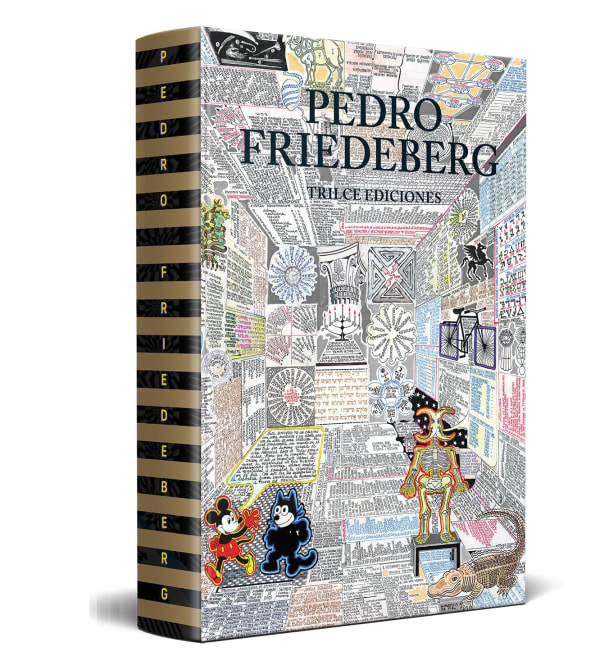
Pedro Friedeberg: 1
2023Hard copy, 484 pagesRead more
Publisher: Trilce Ediciones
Dimensions: 24 x 5.5 x 34.5 cm -

Original Multiple, Obra Estampada de Pedro Friedeberg
Essay by Alejandro Sordo 2018Hardcover, 208 pages pagesRead more
Publisher: SICOMORO
ISBN: 6079660695
Dimensions: 9 X 11 in -

VOZ : Selections from the UTSA Collection, 2018
Essay by Arturo Infante Almeida 2018Hardcopy, 106 pagesRead more
Publisher: Centro de Artes
ISBN: 978-0-9915043-3-6 -

Pedro Friedeberg: La casa irracional
Essays by: Dan Cameron, Alejandro Sordo, José Ignacio Prado Feliu and Karen Cordero Reiman 2018Hardcover, 391 pages pagesRead more
Publisher: Trilce Ediciones
ISBN: 978-607-8460-52-6
Dimensions: 11 x 8.5 x 1.5 inches -
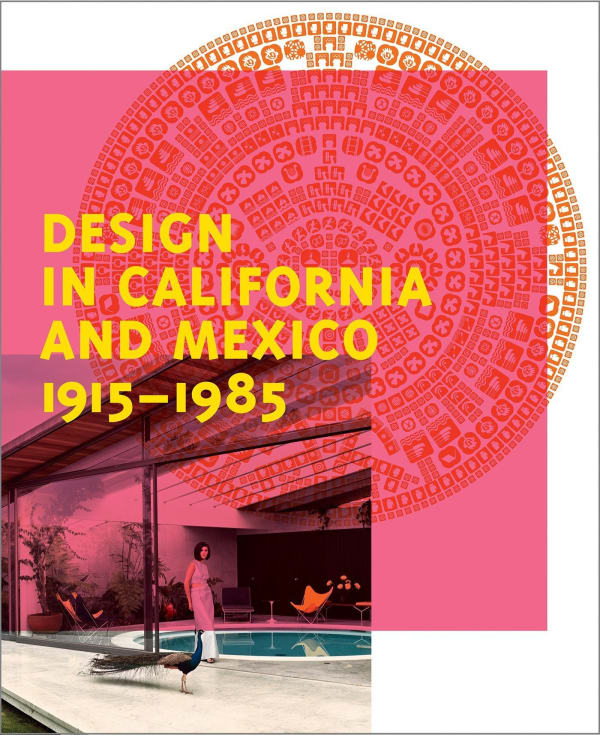
Design in California and Mexico, 1915-1985 I LACMA
Pedro Friedeberg Editor: Wendy Kaplan, 2017Hardcover, 360 pages pagesRead more
Publisher: Prestel
ISBN: 3791356704
Dimensions: 10 x 1.37 x 12.25 in -
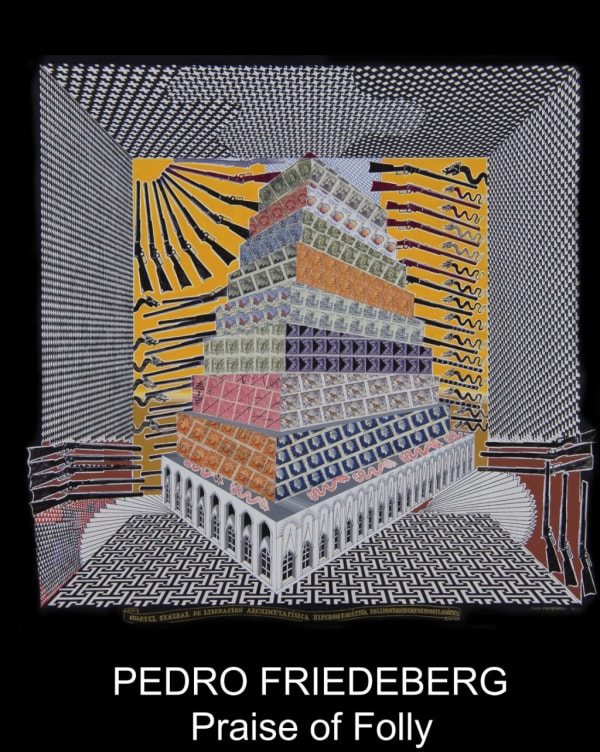
Pedro Friedeberg: Praise of Folly I Ruiz-Healy Art
Essay by Dan Cameron 2016Hardcover, 100 pagesRead more
Publisher: Ruiz-Healy Art
ISBN: 9781389270185
Dimensions: 8×10 in -

Hans Ulrich Obrist: Conversations in Mexico
Authors: Patrick Charpenel and Hans Ulrich Obrist Patrick Charpenel, Hans Ulrich Obrist, 2016Hardcover, 352 pagesRead more
Publisher: Fundación Alumnos 47
ISBN: 9780996215619
Dimensions: 7.5 x 11 in -
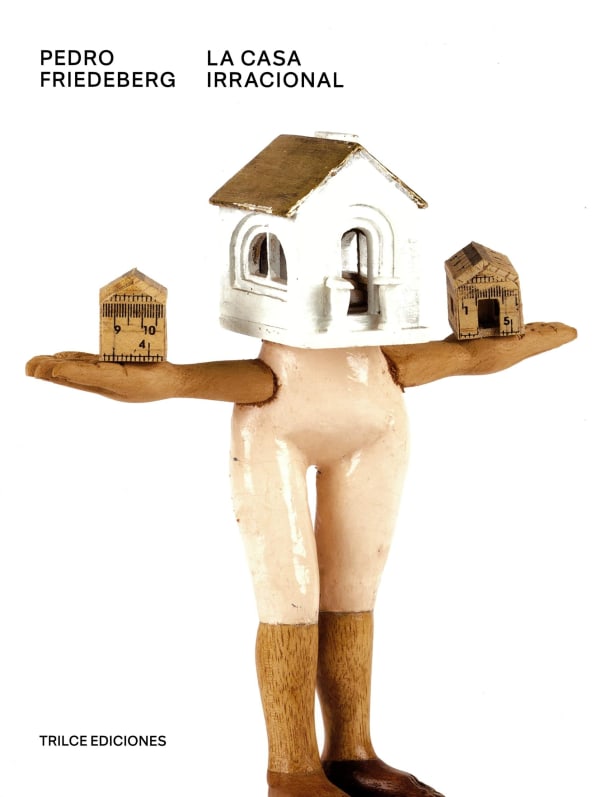
Pedro Friedeberg: La Casa Irracional
Essays by Ida Rodríguez Prampolini, Karen Cordero, Ignacio Prado, Alejandro Sordo, Susan Crowley, Patricia Ruiz-Healy y Dan Cameron. 2014Hardcover, 391 pages pagesRead more
Publisher: TRILCE EDICIONES
ISBN: 6077458945
Dimensions: 10.63 x 8.27 x 0.39 in -
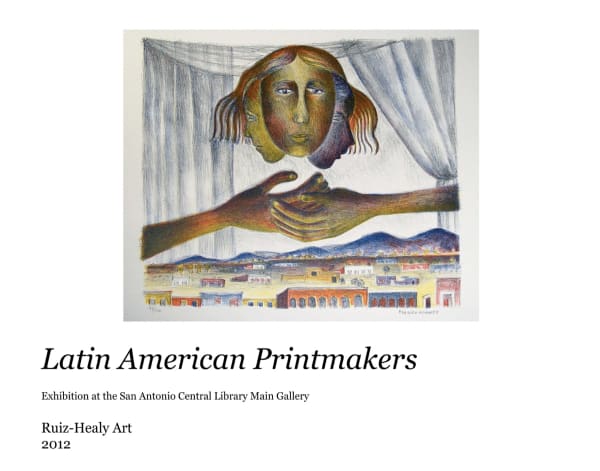
Latin American Printmakers I Ruiz-Healy Art
Text by Patricia Ruiz-Healy and Katy Alexander 2012HardcoverRead more
Publisher: Ruiz-Healy Art
ISBN: 1367417236
Dimensions: 8.5 x 10.5 in -

Cinetismo: movimiento y transformación en el arte de los 60 y 70
Essays on Pedro Friedeberg and Hersúa Daniel Garza Usabiaga, Jennifer Josten, Luis Urias Hermosillo, and Álvaro Vázquez Mantencón, 2012Hardcover, 158 pagesRead more
Publisher: Museo de Arte Moderno
ISBN: 9786076051733
Dimensions: 9 X 10 in -
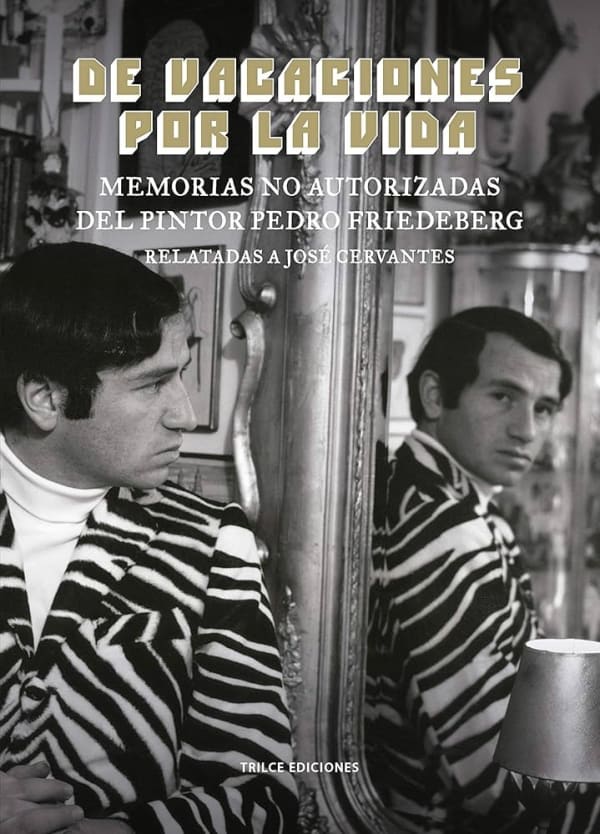
Pedro Friedeberg: De Vacaciones por la Vida
Relatada a Jose Cervantes Pedro Friedeberg y Jose Cervantes, 2011Hard cover, 432 pagesRead more
Publisher: Trilce Ediciones
Dimensions: 17 x 23 cm -
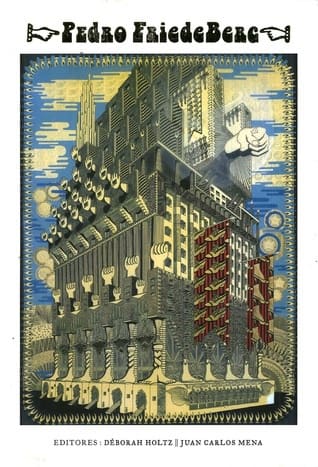
Pedro Friedeberg I Fine Arts Palace, Mexico City
James Oles & Jeffrey Collins Editors: Déborah Holtz & Juan Carlos Mena. Introduction by Luis Carlos Emerich; epilogue by Fernando Gonzáles Gortázar, 2009Hardcover, 448 pagesRead more
Publisher: Fondo de Cultura/Trilce Ediciones
ISBN: 6077663174
Dimensions: 13 x 9 in -

Pedro Friedeberg
Mexico en la X Bienal de Sao Paulo 1969SoftcoverRead more
Publisher: Instituto Nacional de Bellas Artes
Dimensions: 11.25 x 7.5 in
-

McNay Print Fair
San Antonio May 3 - 4, 2025Ruiz Healy Art is delighted to participate in the McNay Print Fair , hosted by the McNay Art Museum in San Antonio, Texas, one of...Read more -

McNay Print Fair
San Antonio May 3 - 5, 2024Read more -

McNay Print Fair
San Antonio May 6 - 7, 2023Read more -
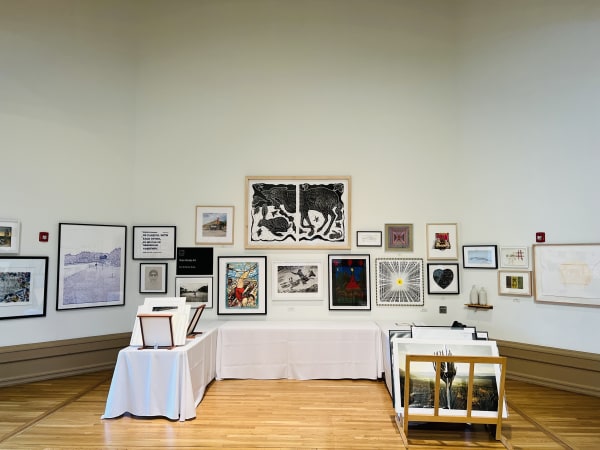
McNay Print Fair
San Antonio April 29 - May 1, 2022Read more
-

IFPDA Fine Art Print Fair
New York City October 7 - November 1, 2020Read more -

IFPDA Fine Art Print Fair
New York City October 23 - 27, 2019Read more -
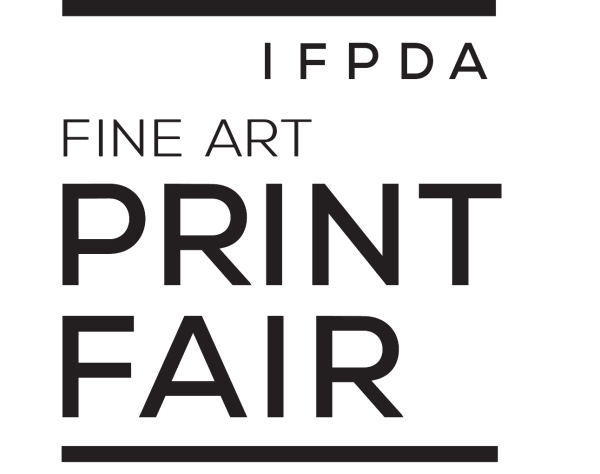
IFPDA Fine Art Print Fair
New York City October 25 - 28, 2018Read more -
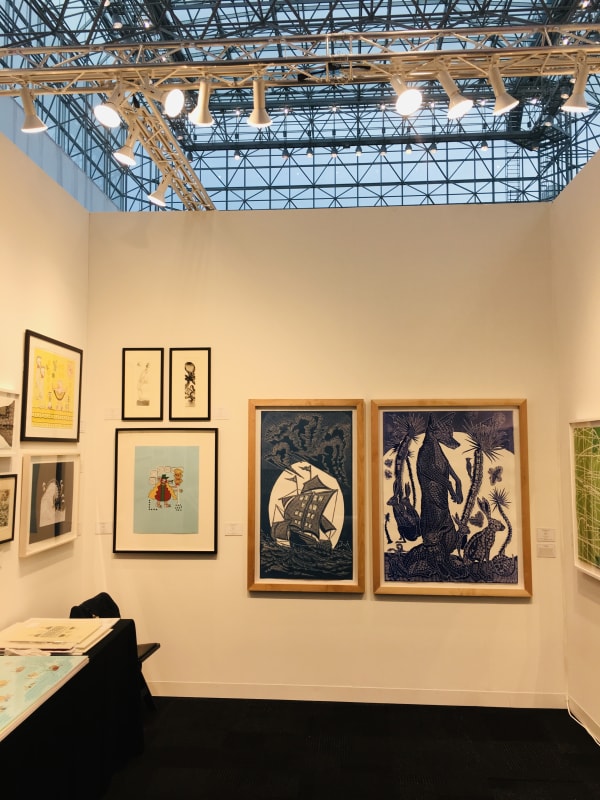
IFPDA Fine Art Print Fair
New York City October 25 - 29, 2017Read more
-
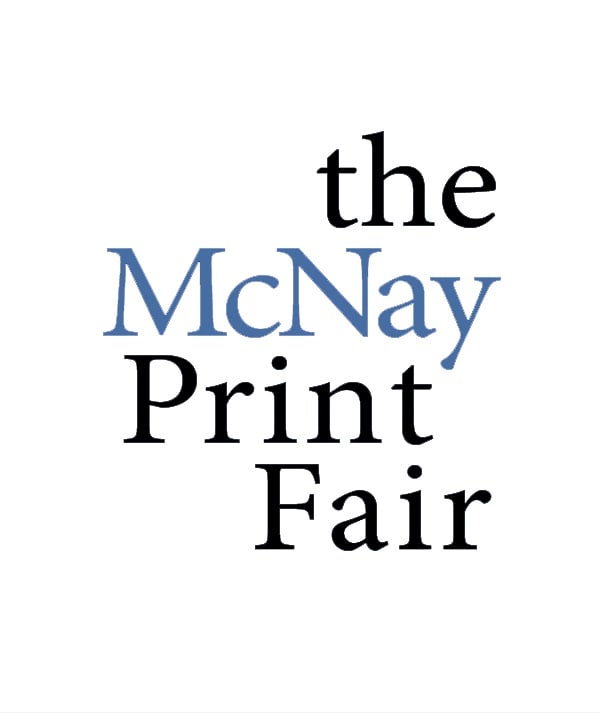
20th Annual McNay Print Fair
San Antonio March 5 - 6, 2016Ruiz-Healy Art is pleased to participate at the Annual McNay Print Fair showcasing works on paper from; Laura Anderson Barbata, Ricky Armendariz, Pedro Friedeberg, Daniel Guerrero, César Martínez, Cecilia Paredes, and Julie Speed, among othersRead more -
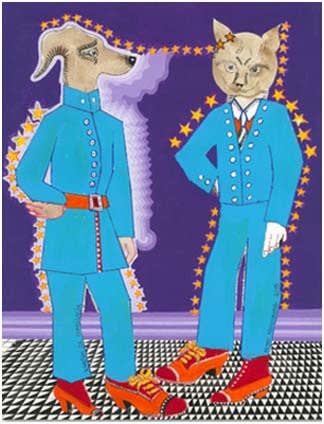
Art on Paper Fair - Pedro Friedeberg
New York City March 3 - 6, 2016Read more -
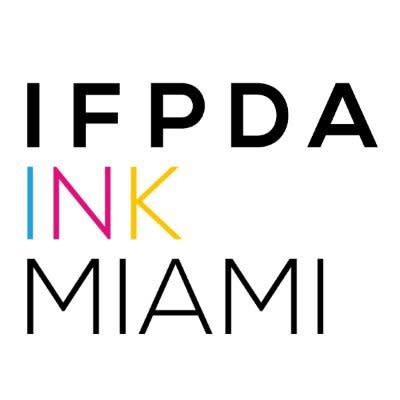
IFPDA Ink Miami Art Fair
Miami December 3 - 7, 2014Read more -

IFPDA San Francisco Fine Art Print Fair
San Francisco January 24 - 26, 2014Read more

